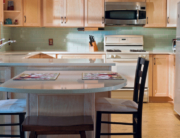Not everyone likes change. And if you’re living in a house you love, you may be sorry to think about having to move one day when your home no longer suits your needs.
This can happen if going up and down stairs starts to become an issue, or if anyone in the family must use a wheelchair or walker at some point.
More and more architects, builders and homeowners are seeing the value of creating homes that will serve us throughout the course of our lives. People are coming to realize the value of “universal design.” Here are six areas to keep in mind if you are considering building or remodeling anytime in the near future.
1. Create a no-step entry
Make sure at least one entry to your home is accessible without steps.
● If you are building a new home, the easiest way to accomplish this is to make the garage floor level with the main floor.
● If you are building a two-story house, consider creating stacked closets with a removable floor to make it easier to add an elevator in the future.
2. Wider doors and hallways are key
● If at all possible, plan for 3-foot doors and 4-foot hallways throughout the house.
● If you are remodeling, enlarge doors to 3 feet wide wherever you can. If this doesn’t fit your budget, use swing-clear hinges, which swing the door clear of the opening and create a wider space to pass through.
For a person using a wheelchair or a walker, a few extra inches of clearance can make all the difference in the world.
3. Bathrooms should be safe and accessible
The bathroom is where many falls occur, and falls can result in seniors being forced to move out of their homes. The following modifications can go a long way toward making the bathroom safer and easier to use:
● A nonslip floor.
● Plenty of grab bars.
● A curbless shower or walk-in tub.
● A higher “comfort height” commode.
4. All controls should be simple to use and easy to access
The principles of universal design refer to this as “simple and intuitive use.” Ever notice how the control panels and remote controls of various gadgets seem to get more and more complicated? Look for appliances, thermostats and other controls that are simple and easy to use.
Mount all switches and outlets between 24 inches and 48 inches from the floor to make them easy for everyone to reach.
5. Good lighting
● Bright, glare-free lighting without shadows will make your home safer for everyone, but especially for anyone with diminished vision.
● Use bright, contrasting colors, particularly at the edges of work surfaces and stairs.
6. Watch the clutter
Make sure walkways are clear and free of tripping hazards. Throw rugs and trailing extension cords are two prime suspects. Preventing falls is probably the best way to keep you or a loved one living at home.
This article was originally published at Angie’s List.






